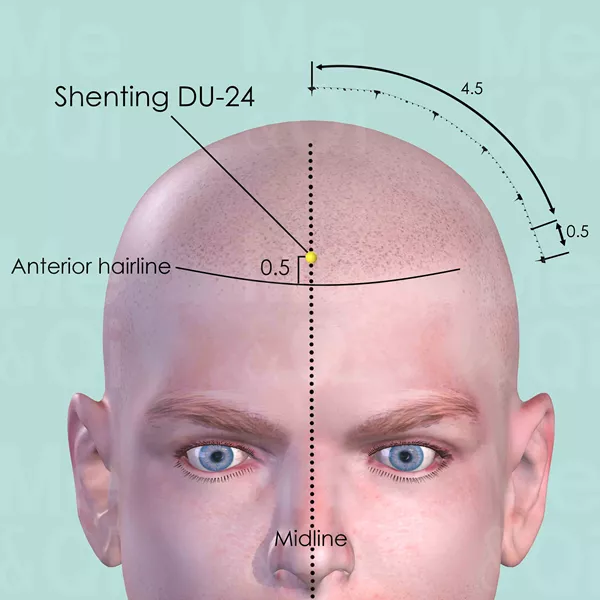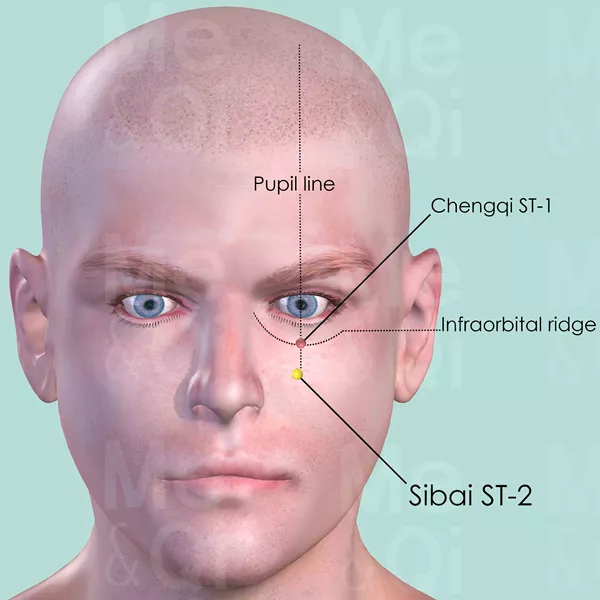Hay Feveraccording to TCM
*redirected from Allergic rhinitis
Symptom families: Allergy related conditions and symptoms, Respiratory Disorders and Symptoms, Nasal Disorders and Symptoms
Parent symptom: Rhinitis
What is Hay Fever?
Hay fever, medically known as allergic rhinitis, is an allergic response to outdoor or indoor allergens, such as pollen, dust mites, or pet dander. This condition is characterized by symptoms like sneezing, itching, nasal congestion, and runny nose, often accompanied by itchy, watery eyes. While not life-threatening, hay fever can significantly impair quality of life, disrupting sleep, and daily activities. The condition varies in severity and can be seasonal, depending on the presence of specific allergens.
How Does TCM View Hay Fever?
From the perspective of Traditional Chinese Medicine (TCM), hay fever is seen as a manifestation of imbalances within the body, particularly due to the invasion of pathogenic factors such as Wind, along with underlying weaknesses in the body's Defensive Qi. TCM doesn't just address the symptoms but seeks to identify the root cause of the disharmony, emphasizing the importance of diagnosing the specific pattern of imbalance. This holistic approach allows for treatments that aim to restore the body's natural balance and strengthen its resistance to external pathogens.
Causes of Hay Fever According to TCM
In TCM, the onset of hay fever is primarily attributed to the invasion of Wind-Cold or Wind-Heat, coupled with an inherent weakness in the body's protective Qi. Wind-Cold patterns are characterized by symptoms like clear nasal discharge and sneezing, while Wind-Heat patterns may present with yellowish nasal discharge and a sensation of warmth.
An underlying Qi Deficiency, particularly of the Lung and Spleen, can leave the body vulnerable to these external invasions, highlighting the necessity of a treatment approach that both expels pathogenic factors and nurtures the body's vital energy.
TCM Herbal Formulas for Hay Fever
To combat hay fever, TCM recommends a variety of formulas and herbs tailored to address both the symptoms and the underlying imbalances. For patterns of Wind-Cold invasion, formulas such as Ge Gen Tang and Gui Zhi Tang are used to expel the cold and harmonize the body's Qi. In cases of Qi Deficiency, Bu Fei Tang and Yu Ping Feng San can help to strengthen the Lung Qi and bolster the body's defenses.
Additionally, Cang Er Zi San and Xin Yi San are effective in dredging and dispersing External Wind, directly targeting nasal symptoms. These treatments exemplify TCM's multifaceted approach, aiming not only to alleviate immediate discomfort but also to prevent future occurrences by restoring and maintaining the body's harmony.
Explore below some TCM herbal formulas used to address hay fever, organized by formula type.
- By Formula Type
- Formulas that clear wind-Cold
- Formulas that tonify qi
- Formulas that dredge and disperse external wind
- Formulas that warm interior cold
- Formulas that clear wind-Heat
- Formulas that warm the middle and dispel cold
- Formulas that clear exterior disorders with interior deficiency
- Formulas that warm and open sensory orifices
- Formulas that harmonize lesser yang-warp disorders
- Formulas that clear heat from the organs
Formulas that clear Wind-Cold
Hay fever can be treated by these formulas when it stems from external pathogenic influences characterized by cold and wind symptoms.
One such formula is Ge Gen Tang, with kudzu root as a key herb.
Other formulas of this category are listed in the table below.
All "formulas that clear wind-Cold" recommended for hay fever
| Formula | Key herbs |
|---|---|
| Ge Gen Tang | Kudzu Roots (Ge Gen) |
| Gui Zhi Tang | Cinnamon Twigs (Gui Zhi) |
| Xiao Qing Long Tang | Ephedra (Ma Huang), Cinnamon Twigs (Gui Zhi) |
| Ma Huang Tang | Ephedra (Ma Huang) |
Formulas that tonify Qi
Hay fever can be treated by these formulas if it results from Qi deficiency, necessitating treatments that boost the body's vital energy.
One such formula is Bu Fei Tang, with ginseng as a key herb.
Other formulas of this category are listed in the table below.
All "formulas that tonify qi" recommended for hay fever
| Formula | Key herbs |
|---|---|
| Bu Fei Tang | Ginseng (Ren Shen), Milkvetch Roots (Huang Qi) |
| Yu Ping Feng San | Milkvetch Roots (Huang Qi) |
Formulas that dredge and disperse External Wind
Hay fever can be treated by these formulas when it results from external wind invasion disrupting the body's surface and normal function, requiring wind-dispersing actions.
One such formula is Cang Er Zi San, with cocklebur fruit as a key herb.
Other formulas of this category are listed in the table below.
All "formulas that dredge and disperse external wind" recommended for hay fever
| Formula | Key herbs |
|---|---|
| Cang Er Zi San | Cocklebur Fruits (Cang Er Zi ), Biond’S Magnolia Flowers (Xin Yi Hua) |
| Xin Yi San | Biond’S Magnolia Flowers (Xin Yi Hua), Bugbane Rhizomes (Sheng Ma) |
Formulas that warm Interior Cold
Hay fever can be treated by these formulas when it is caused by an internal cold condition, needing treatments that warm the body's interior.
One such formula is Gan Cao Gan Jiang Tang, with dried ginger as a key herb.
Formulas that clear Wind-Heat
Hay fever can be treated by these formulas if it originates from a wind-heat invasion.
One such formula is Jing Jie Lian Qiao Tang, with japanese catnip as a key herb.
Formulas that warm the middle and dispel Cold
Hay fever can be treated by these formulas when it is due to cold in the middle jiao (digestive region), necessitating warming and cold-dispelling actions.
One such formula is Li Zhong Wan, with dried ginger as a key herb.
Formulas that clear Exterior disorders with Interior deficiency
Hay fever can be treated by formulas that clear Exterior disorders with Interior deficiency if it arises from an external pathogen attacking a body with underlying weakness.
One such formula is Ma Huang Xi Xin Fu Zi Tang, with ephedra as a key herb.
Formulas that warm and open sensory orifices
Hay fever can be treated by these formulas when it is due to cold affecting the sensory orifices, requiring warming and opening actions.
One such formula is Su He Xiang Wan, with styrax resin as a key herb.
Formulas that harmonize lesser Yang-warp disorders
Hay fever can be treated by these formulas in cases of imbalances in the lesser Yang (Shao Yang) phase, which often involve alternating hot and cold sensations.
One such formula is Xiao Chai Hu Tang, with bupleurum root as a key herb.
Formulas that clear Heat from the Organs
Hay fever can be treated by these formulas if it stems from an excess heat condition in specific organs, leading to internal disharmony.
One such formula is Xin Yi Qing Fei Yin, with biond’s magnolia flowers as a key herb.
Acupoints for Hay Fever
TCM acupuncture offers additional relief for hay fever by targeting specific acupoints known to benefit nasal symptoms and overall well-being. Points such as Shangxing DU-23 and Shenting DU-24 are selected for their ability to clear the nasal passages and calm the mind. Hegu LI-4 and Yingxiang LI-20 are crucial for expelling Exterior Wind and opening the nose, offering symptomatic relief.
Furthermore, Fengmen BL-12 strengthens the body's resistance against pathogenic Wind, supporting the treatment's efficacy. Stimulating these acupoints can enhance the effectiveness of herbal treatments, providing a comprehensive strategy to manage and mitigate the symptoms of hay fever effectively.
Explore below some acupoints used to address hay fever, organized by meridian.
- By Meridian
- Governing Vessel
- Large Intestine Channel
- Bladder Channel
- Extra Points: Head and Neck (EX-HN)
- Stomach Channel
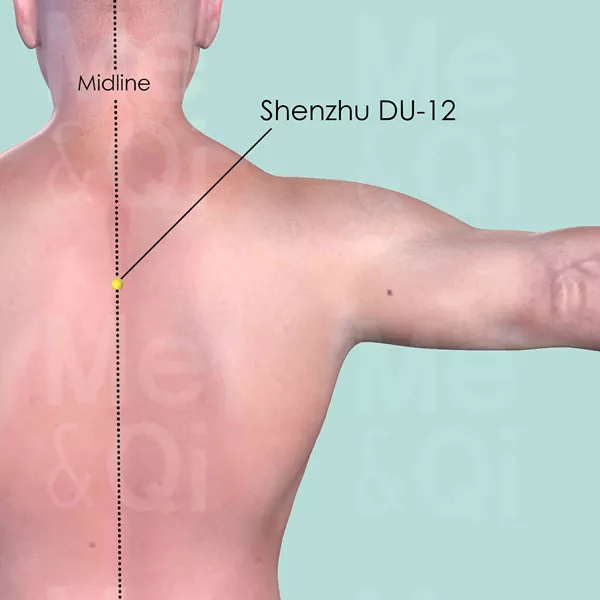
Shenzhu DU-12
On the back midline, in the depression below the spinous process of the 3th thoracic vertebra (T3).
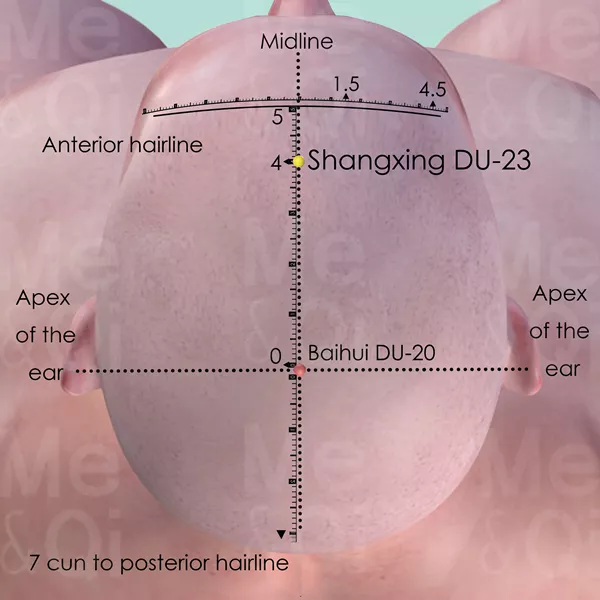
Shangxing DU-23
On the head midline, 1 cun within anterior to the front hairline, 4 cun anterior to Baihui DU-20.
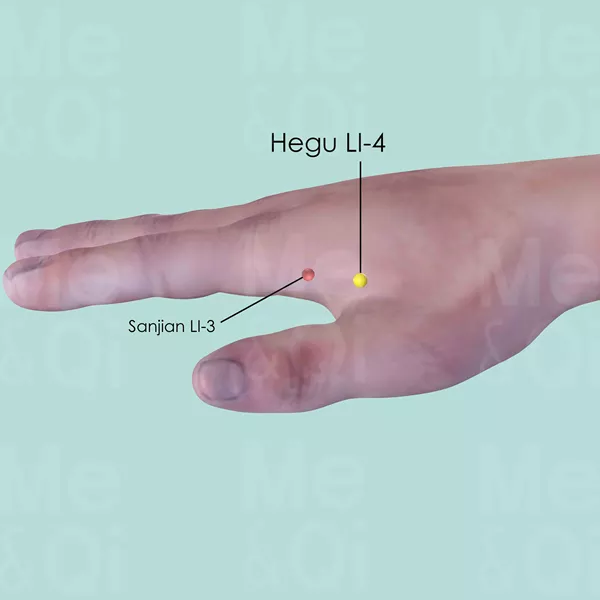
Hegu LI-4
Between the 1st and 2nd metacarpal bones, approximately in the middle of the 2nd metacarpal bone on the radial side.
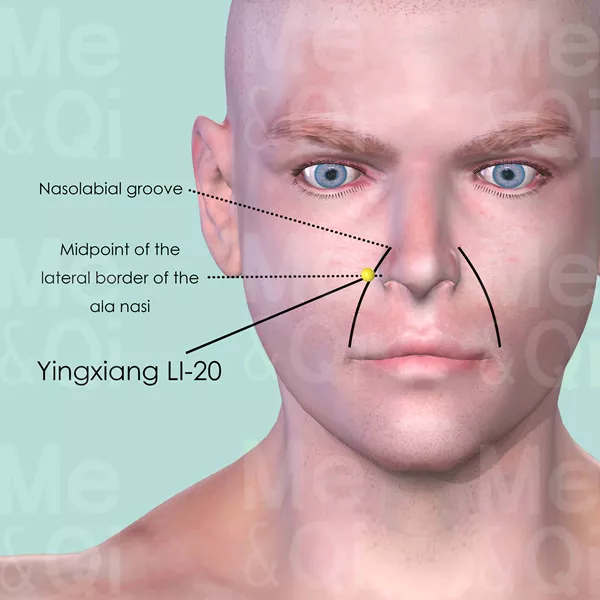
Yingxiang LI-20
In the nasolabrial groove, at the level of the midpoint of the lateral border of ala nasi.
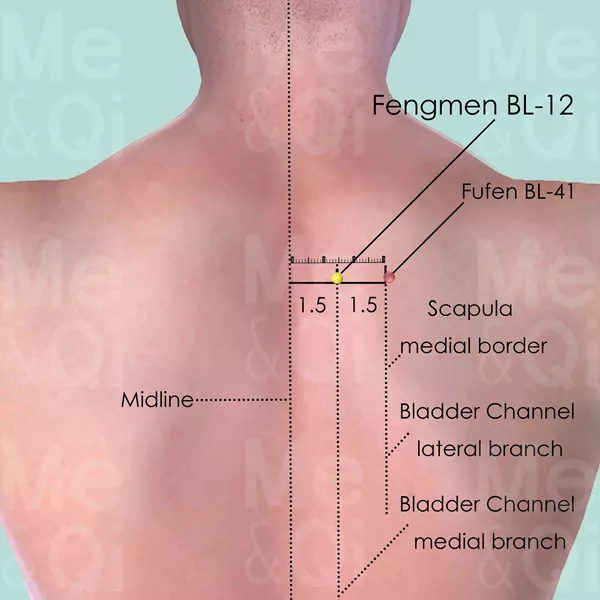
Fengmen BL-12
1.5 cun lateral to the lower border of the spinous process of the 2nd thoracic vertebra (T2).
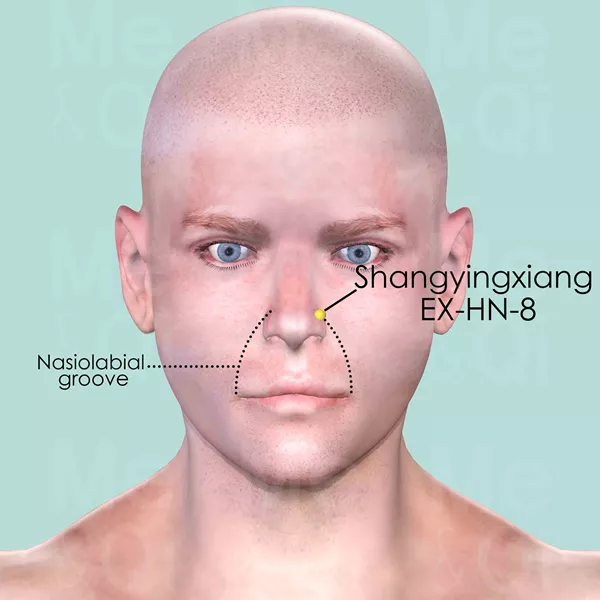
Shangyingxiang EX-HN-8
At the upper end of the nasiolabial groove, at the junction of the maxilla and the nasal cavity.
TCM Herbs for Hay Fever
Explore below some TCM herbs used to address hay fever, organized by herb category.
- By Herb Category
- Warm/Acrid herbs that release the exterior
- Herbs that open the orifices
- Cool/Acrid herbs that release the exterior
- Tonic herbs for qi deficiency
- Herbs that invigorate the blood
- Herbs that dispel wind and dampness
- Herbs that warm the interior and/or expel cold
- Herbs that clear heat and relieve toxicity
Warm/Acrid herbs that release the Exterior
Hay fever can be treated by these herbs when there is a need to dispel external cold and warm the body, especially in cases where there is insufficient Yang energy internally.
One such herb is Biond’S Magnolia Flowers (Xin Yi Hua), a key herb in some formulas recommended for hay fever, like Cang Er Zi San.
Other herbs of this category are listed in the table below.
"Warm/Acrid herbs that release the Exterior" recommended for hay fever
| Herb | Formulas they belong to (if applicable) |
|---|---|
| Biond’S Magnolia Flowers (Xin Yi Hua) | Cang Er Zi San | Xin Yi Qing Fei Yin | Xin Yi San |
| Ephedra (Ma Huang) | Ma Huang Xi Xin Fu Zi Tang | Xiao Qing Long Tang | Ma Huang Tang |
| Cinnamon Twigs (Gui Zhi) | Gui Zhi Tang | Xiao Qing Long Tang |
| Japanese Catnip (Jing Jie) | Jing Jie Lian Qiao Tang |
Herbs that open the Orifices
Hay fever can be treated by these herbs if it's a result of blockages in the body's sensory orifices, aiding in restoring clarity and consciousness.
One such herb is Styrax (Su He Xiang), a key herb in some formulas recommended for hay fever, like Su He Xiang Wan.
Other herbs of this category are listed in the table below.
"Herbs that open the Orifices" recommended for hay fever
| Herb | Formulas they belong to (if applicable) |
|---|---|
| Styrax (Su He Xiang) | Su He Xiang Wan |
| Musk (She Xiang) | Su He Xiang Wan |
| Borneol (Bing Pian) | Su He Xiang Wan |
| Benzoin (An Xi Xiang) | Su He Xiang Wan |
Cool/Acrid herbs that release the Exterior
Hay fever can be treated by these herbs when the body needs to harmonize with external environmental changes, particularly when there's a need to expel pathogenic factors like wind or cold without overly cooling the body.
One such herb is Kudzu Roots (Ge Gen), a key herb in some formulas recommended for hay fever, like Ge Gen Tang.
Other herbs of this category are listed in the table below.
"Cool/Acrid herbs that release the Exterior" recommended for hay fever
| Herb | Formulas they belong to (if applicable) |
|---|---|
| Kudzu Roots (Ge Gen) | Ge Gen Tang |
| Bupleurum Roots (Chai Hu) | Xiao Chai Hu Tang |
| Bugbane Rhizomes (Sheng Ma) | Xin Yi San |
Tonic herbs for Qi Deficiency
Hay fever can be treated by these herbs when stemming from a lack of vital energy or Qi, helping to boost energy and overall vitality.
One such herb is Milkvetch Roots (Huang Qi), a key herb in some formulas recommended for hay fever, like Bu Fei Tang.
Other herbs of this category are listed in the table below.
"Tonic herbs for Qi Deficiency" recommended for hay fever
| Herb | Formulas they belong to (if applicable) |
|---|---|
| Milkvetch Roots (Huang Qi) | Bu Fei Tang | Yu Ping Feng San |
| Ginseng (Ren Shen) | Bu Fei Tang |
Herbs that invigorate the Blood
Hay fever can be treated by these herbs when it stems from stagnation or poor circulation of blood, helping to improve blood flow and alleviate related discomfort.
One such herb is Sweetgum Fruits (Lu Lu Tong), which is directly recommended for hay fever.
Herbs that dispel Wind and Dampness
Hay fever can be treated by these herbs when it is due to the invasion or accumulation of wind and dampness, which often affects the muscles and joints.
One such herb is Cocklebur Fruits (Cang Er Zi ), a key herb in some formulas recommended for hay fever, like Cang Er Zi San.
Herbs that warm the Interior and/or expel Cold
Hay fever can be treated by these herbs if it is due to internal coldness or deficient Yang energy, working to warm the body and dispel cold.
One such herb is Dried Ginger (Gan Jiang), a key herb in some formulas recommended for hay fever, like Gan Cao Gan Jiang Tang.
Herbs that clear Heat and relieve Toxicity
Hay fever can be treated by these herbs if it arises from internal heat and toxic accumulations, aiding in detoxification and cooling the body.
One such herb is Forsythia Fruits (Lian Qiao), a key herb in some formulas recommended for hay fever, like Jing Jie Lian Qiao Tang.

